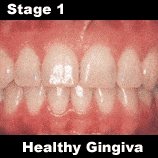
Periodontal diseases are classified according to the severity of the disease. The two major stages of the disease are gingivitis and periodontitis.
Gingivitis
Gingivitis is a milder and reversible form of periodontal disease that only affects the gums. It develops as toxins in plaque irritating gums, making them red, tender, swollen and likely to bleed easily. It can usually be eliminated by daily brushing, cleaning between your teeth, and regular dental cleanings.
Periodontitis
Gingivitis may lead to more serious, destructive forms of periodontal disease, called periodontitis. There are several forms of periodontitis, with the most common being chronic adult periodontitis.
Periodontitis occurs when toxins, enzymes, and other plaque byproducts destroy the tissues that anchor teeth into the bone. The gum line recedes, which can expose the tooth’s root. Exposed roots can become susceptible to decay and sensitive to cold and touch.
The sulcus deepens into a pocket in the early stage of periodontal disease. Plaque that collects in these pockets can be difficult to remove during regular brushing and interdental cleaning. Byproducts from the plaque that collect in these pockets can continue to damage the gums, periodontal ligament and bone. In some cases, so much ligament and bone are destroyed that the tooth becomes loose. Usually, your dentist can still treat the disease at this point. In the worst cases, a loose tooth may need to be extracted or may fall out on its own.





